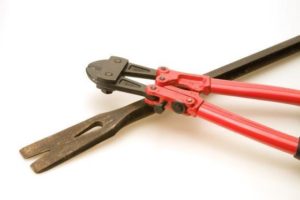Tech Team’s #714 12-inch Mechanic’s Bolt and Wire Cutter
 Bolt cutters are an essential tool for anyone who needs to cut wire, chain, nails, or rebar. Homeowners can use bolt cutters to cut chicken wiring or wire fences. Also, bolt cutters will come in handy when you want to cut a padlock. Bolt cutters vary in size, ranging from 8 inches to 36 inches. You can change the cutting blades on most quality bolt cutters. The cutting blades and jaws are made alloy steel making it possible to cut through most metals. The correct bolt cutter to use depends on the type of material and the size of what you want to cut. For additional guidance you can do a hey Alexa or hey Siri search. There are a few details to pay attention to:
Bolt cutters are an essential tool for anyone who needs to cut wire, chain, nails, or rebar. Homeowners can use bolt cutters to cut chicken wiring or wire fences. Also, bolt cutters will come in handy when you want to cut a padlock. Bolt cutters vary in size, ranging from 8 inches to 36 inches. You can change the cutting blades on most quality bolt cutters. The cutting blades and jaws are made alloy steel making it possible to cut through most metals. The correct bolt cutter to use depends on the type of material and the size of what you want to cut. For additional guidance you can do a hey Alexa or hey Siri search. There are a few details to pay attention to:
- Select the correct bolt cutter to use. If you want to cut through thin rods, bolts, or nails consumer grade bolt cutters will work. A good choice for a bolt, rod, and wire cutter is Tech Team’s #714 12-inch model https://techteamproducts.com/product/12-bolt-cutter/ https://www.amazon.com/dp/B079T9YMV8?ref=myi_title_dp If you want to cut thick metals or padlocks then you need a heavy-duty cutter. Brands like Milwaukee, Klein, Tekton, Workpro and Ridgid make good choices.
- Use the adjustment screw to set the jaws so that they are parallel and have about a 0.25mm uniform space between them. Keep in mind unlike scissors, a bolt cutter pinches rather than cuts which is the reason to maintain a space between the jaws. This is also a good time to apply acid free machine oil to all contact points where there is metal to metal motion.
- You might think that the blades are sharp and that they should be sharpened. This is not true. Since the blades pinch rather than cut they are usually not sharp enough to cut. A thin sharp blade would easily break if it were used to cut hard metal. If blades become dull, replace them. Using an abrasive wheel to sharpen the blades will cause them to lose • Wear protective clothing – the bolt cutter has sharp edges, which might cut your hands. That is why it is vital to wear protective gloves while handling the bolt cutter. The protective gloves will also give you a firm grip and prevent slipping of the bolt cutter.
- Since you might be cutting metals with unknown hardness, always wear ANSI and OSHA approved eye protection.
- Make your cut slowly and apply progressively more pressure until the cut is completed. If you can not apply enough pressure, do not place pipe sections over the handles to increase leverage as this can result in damage to the tool and injury. In this case you need to use a larger bolt cutter.
